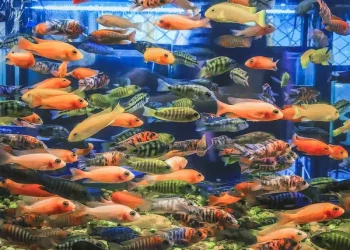Lungfish are a type of fish that have been around for over 400 million years. They are often considered to be one of the most primitive types of fish still in existence. There are six different species of lungfish, which are found in Africa, South America, and Australia. These fish have a number of unique characteristics that set them apart from other fish species.
One of the most notable features of lungfish is their ability to breathe air. Unlike most fish, which extract oxygen from water using their gills, lungfish have lungs that allow them to breathe air. This adaptation is thought to have evolved as a way for the fish to survive in habitats where the water levels fluctuate, leaving them temporarily stranded in shallow pools or swamps. By being able to breathe air, lungfish can survive for extended periods of time without water.
Lungfish also have a unique method of swimming. Instead of using their fins to propel themselves through the water, they undulate their bodies in a wave-like motion, which allows them to move forward. This swimming style is similar to the way that eels and some types of snakes move.
Another unusual characteristic of lungfish is their ability to enter a state of dormancy when water levels drop. During periods of drought, lungfish can burrow into the mud and secrete a mucus-like substance that surrounds them in a cocoon. They can then remain in this dormant state for months or even years until the water levels rise again. This adaptation allows lungfish to survive in environments that would be inhospitable to other fish species.
In addition to their unique physical adaptations, lungfish also have an interesting place in human history. They have been eaten by humans for thousands of years and are still considered a delicacy in some parts of the world. The Australian lungfish, in particular, has a cultural significance to the Indigenous peoples of the area, who believe that the fish has spiritual properties.
Overall, lungfish are a fascinating group of fish with a number of unique adaptations that have allowed them to survive for millions of years. Their ability to breathe air, their unusual swimming style, and their ability to enter a state of dormancy all make them a special and fascinating species.

























